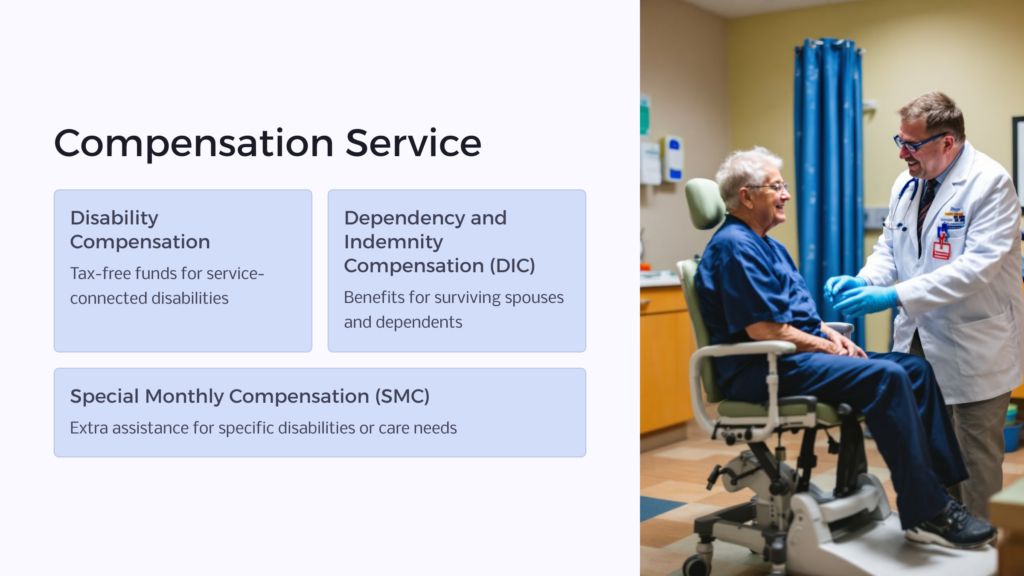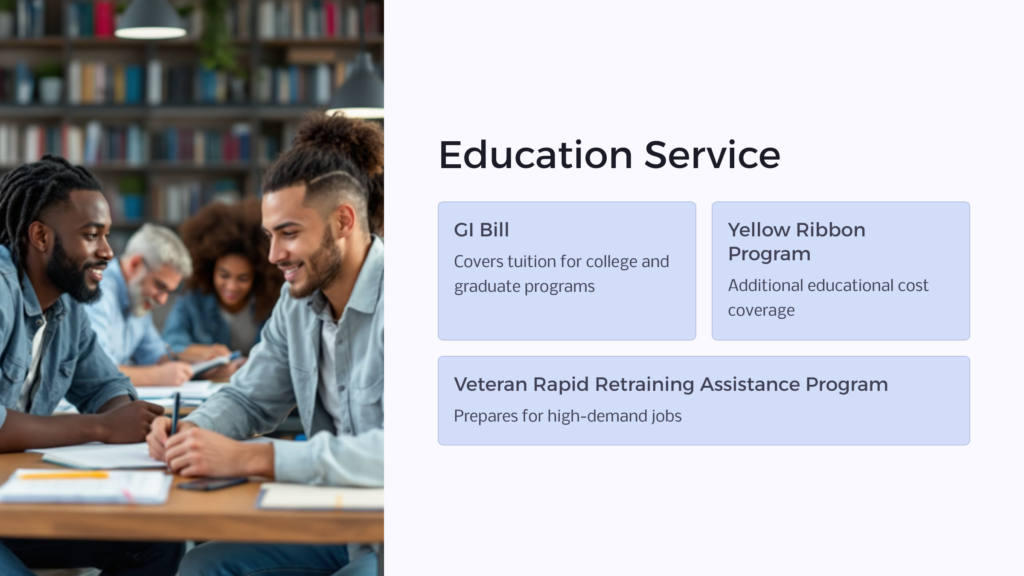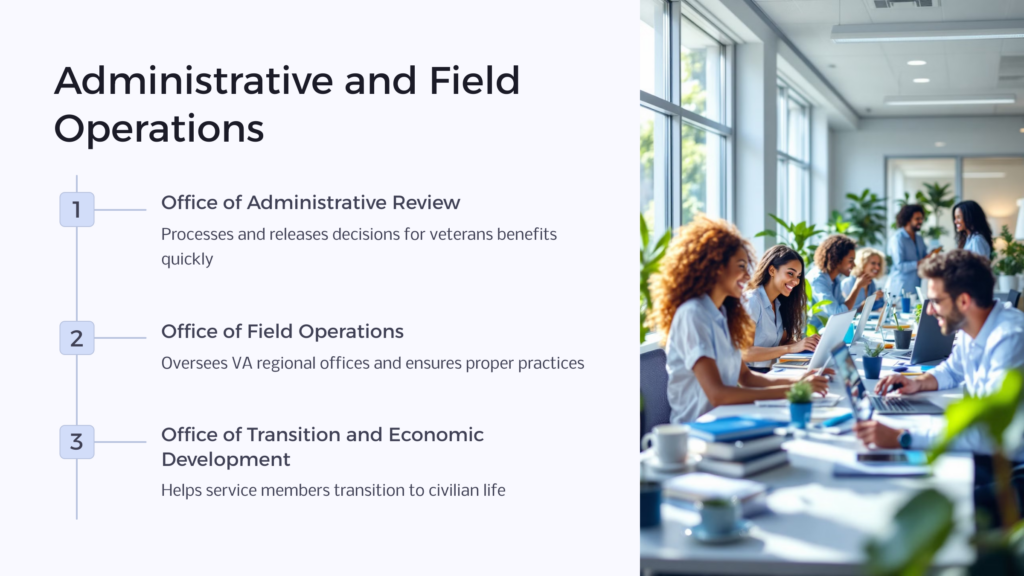A sub-agency of the United States Department of Veterans Affairs (VA), the Veterans Benefits Administration (VBA) is responsible for managing veteran benefit funds and programs. If you’ve applied for a VA benefits program, like education benefits, loan guaranty, pension services, or disability compensation, your benefits will be managed by the VBA.
9 Major Programs of the Veterans Benefits Administration
- Compensation Service
- Education Service
- Insurance Service
- Loan Guaranty Service
- Office of Administrative Review
- Office of Field Operations
- Office of Transition and Economic Development
- Pension and Fiduciary Service
- Veteran Readiness & Employment (VR&E) Service
As a current active duty service member or veteran of the military service, you’re entitled to various types of assistance. One of the most common veterans’ services is disability compensation, which awards funds to veterans with a service-connected disability.
Other earned benefits include surviving spouse benefits, VA health care, vocational rehabilitation, and housing grants. The Veterans Benefits Administration plays a pivotal role in these programs, ensuring that they reach active duty service members and veterans who need them.
What Is the Veterans Benefits Administration?
Upon leaving the service, veterans may be eligible for veteran benefits exclusive to past service members, including a VA home loan, pension, and vocational rehabilitation to get back into the traditional workforce. The Veterans Benefits Administration manages multiple programs for veteran benefits, each of which offers a different service to veterans.
While each program operates separately, the VBA oversees them all. In turn, the VA oversees the VBA to ensure that each service is properly administered to veterans in the way they were intended.
The overall mission of the Veterans Benefits Administration is to grant services and funds to veterans and their families as quickly as possible. The VBA carries out its mission through its four main branches: Office of Strategic Planning, Office of the Deputy Under Secretary for Disability Assistance, Office of the Deputy Under Secretary for Economic Opportunity, and Office of the Deputy Under Secretary for Field Operations. Together, they plan, oversee, administer, and hold records of veterans benefit programs.
9 Major Programs of the Veterans Benefits Administration
The Veterans Benefits Administration oversees several programs relating to veteran benefits, including VA education benefits and VA disability benefits. Below are nine top programs offered through the VBA to assist veterans and service members.
1. Compensation Service

The VBA’s Compensation Service covers multiple programs related to disability resulting from active duty service. This department ensures that service members and qualified veterans receive their disability compensation from a service-connected disability. Funds from a disability claim are tax-free for the recipient.
The Compensation Service also assists with other forms of VA compensation, including survivor benefits for spouses and dependents, known as Dependency and Indemnity Compensation (DIC). These benefits pay to immediate families of a person who dies while on active duty service, inactive duty service, or training for active duty service. These funds are also tax-free for recipients.
The VBA also pays funds known as Special Monthly Compensation (SMC), which are paid to veterans, their spouses, or their parents. This form of compensation is reserved for veterans who need extra assistance and care due to a disability or live with a specific type of disability as a result of their service.
2. Education Service

The Veterans Benefits Administration oversees the many educational benefits available to eligible servicemembers and veterans. Most notable is the GI Bill, which helps veterans pay for training, college, and graduate programs with tuition coverage. The bill also helps veterans pay for their dependents’ education through programs that cover tuition for eligible children or survivors.
Some schools may also participate in the Yellow Ribbon Program, which helps veterans pay for schooling and other educational costs that the GI Bill won’t cover. Other educational benefit options through the VBA include Tutorial Assistance to pay for tutors, the Edith Nourse Rogers STEM Scholarship for extra money toward college, and the Tuition Assistance Top-Up for extra benefits toward tuition.
Veterans may also utilize the Veteran Rapid Retraining Assistance Program (VRRAP) to get the tools they need to find and prepare for suitable employment in high-demand job areas.
3. Insurance Service
The Insurance Service program manages life insurance benefits for veterans. Life insurance through the VA protects a veteran’s finances and allows dependents and spouses to also have financial security if the veteran dies.
VA insurance programs take on many forms, and it’s important for veterans to know which programs they might qualify for. Servicemembers can get group life insurance, known as Servicemembers’ Group Life Insurance (SGLI), while veterans can get Veterans’ Group Life Insurance (VGLI). Other programs include Traumatic Injury Protection (TSGLI), Veterans’ Mortgage Life Insurance (VMLI), and Service-Disabled Veterans Insurance (S-DVI).
The VBA also manages Family Servicemembers’ Group Life Insurance (FSGLI), which is a form of life insurance that covers a servicemember’s dependents and spouse. Servicemembers must be on active duty service or a member of the National Guard or Ready Reserve and have SGLI benefits.
4. Loan Guaranty Service
Veterans, servicemembers, and their surviving spouses may be eligible for the VBA’s Loan Guaranty Service, which assists with affordable home loans. The VA works with private lenders and financial institutions to provide exclusive home loans for veterans and service members with low interest rates and a guaranteed backing by the VA. The loan guaranty allows veterans who may not qualify for a traditional home loan due to finances and credit the ability to purchase a home.
Like other VBA programs, the Loan Guaranty Service offers a few different programs to fit various situations. Adapted House Grants allow disabled servicemembers and veterans to purchase a home with necessary adaptations or modify their current home to make it more livable. The Interest Rate Reduction Refinance Loan (IRRRL) allows lower-than-traditional interest rates for home refinances.

5. Office of Administrative Review
Formerly known as the Appeals Management Office, the Office of Administrative Review (OAR) works to process and release decisions for veterans benefits quickly. OAR collects and reviews the information given by the veteran, the veteran’s VA regional office, and other organizations or medical professionals working with the veteran regarding a claim.
The primary goal of the OAR is to carry out the Veteran Appeals Improvement and Modernization Act of 2017, which streamlines the claims and appeals process to move VA claims through the system as quickly as possible. Since implementing new procedures and policies, the OAR has significantly reduced the number of legacy appeals awaiting VA review.
6. Office of Field Operations
The Office of Field Operations oversees VA regional offices and other departments of the VA, including the Office of Administrative Review and Compensation Service initiatives. The Office of Field Operations ensures that required practices within the VA and its departments are carried through properly through training, procedural updates, and adherence to VA policies.
The Office of Field Operations is a pivotal piece of the VA and VBA, as it collaborates with several parts of the VA. For example, the Office of Field Operations works with Compensation Service programs to make sure that all contractors and VA workers are kept up-to-date with skill certifications necessary for processing compensation claims. The Veteran Readiness & Employment Service also partners with this office to correct errors in applications or claims that are handled through VA regional offices.
7. Office of Transition and Economic Development
The Office of Transition and Economic Development (OTED) seeks to help service members transition from service to the outside world by finding suitable jobs and living independently. This office works with the VA and federal agencies to provide service members and veterans with career planning, healthcare, and job training. The office also partners with local resources to offer economic development assistance to areas that may be lacking in support for veterans in terms of finding suitable jobs and getting back to work.
OTED manages several programs relating to the veteran workforce and the jobs available for veterans. One such program is the VA Transition Assistance Program (TAP), which offers resources for servicemembers to prepare them to transition back to civilian life and jobs. The program features a course that informs veterans about the many benefits available to them that could help them secure work, find a home, and support their families.

8. Pension and Fiduciary Service
The VBA’s Pension Service and Fiduciary Service are similar programs designed to help veterans and their families receive and manage supplemental funds and benefits. The pension program offers supplemental payments to veterans and their families who undergo financial challenges. The fiduciary program offers aid to qualified veterans who are unable to manage their finances or VA benefits due to a disability, age, or another condition.
The VA Pension Program can take on two forms: pensions for veterans and pensions for survivors of deceased veterans. Specifically, this program aids wartime veterans and their survivors. For a survivor to qualify for the benefit, they must be low-income and either an unmarried child or an un-remarried spouse.
The Fiduciary Service appoints a fiduciary to a veteran after receiving ample medical proof or court documentation that the veteran cannot safely manage their finances or veterans benefits. A fiduciary may be a close and trusted family member, or the VA may decide to appoint another qualified individual, depending on the veteran’s circumstances.
9. Veteran Readiness & Employment (VR&E) Service

The VR&E program offers military individuals services designed to help them transition back to work upon leaving the service. These services are mostly geared toward individuals with a service-connected disability who may find it challenging working in the job they had prior to service or find a new job that fits their skills and interests.
The VR&E program includes different tracks that cater to specific situations. For example, the Reemployment Track assists veterans who would like to return to the job they were doing before they entered the service. The Self-Employment Track gives veterans training, tools, and financial assistance they might need to start their own business. The Independent Living Track helps individuals with a disability get accommodations and support they need to live on their own and support themselves or their families.
Assistance from the Veterans Benefits Administration
The VBA is an agency of the VA that assists service members, veterans, and their families get the support they need to manage their finances, work, train, and even purchase a home. With the help of the VBA’s programs and departments, the VA can review and provide decisions on claims and get veterans the assistance they need in a timely manner.
While each program functions separately, they rely on one another to help veterans comprehensively get the services they need. If you’re interested in applying to any of the services or programs, contact your regional VA office, or visit the VBA website for more information on eligibility and applying.
 Benefits.com Advisors
Benefits.com Advisors
With expertise spanning local, state, and federal benefit programs, our team is dedicated to guiding individuals towards the perfect program tailored to their unique circumstances.
Rise to the top with Peak Benefits!
Join our Peak Benefits Newsletter for the latest news, resources, and offers on all things government benefits.





















